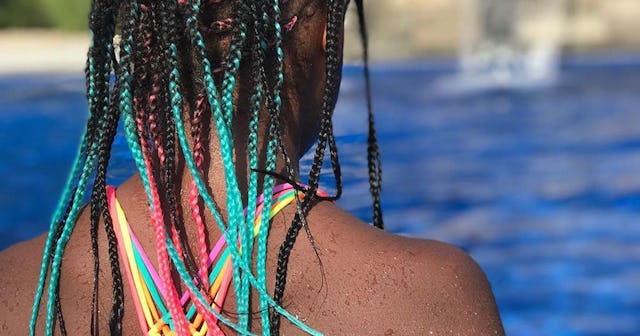Folks Are Really Taking Their 'Gwyneth Goop' Inspo Too Far Now

One day while preparing to swim, my friend and I were slathering five kids with sunscreen. I had a tube I’d picked up at Target a few days before. She had an antique jar. When I asked her what the deal was, she said she’d discovered a sunscreen recipe on Pinterest—and making her own was going to save her some serious cash that summer.
Her kids are the type who burn within four seconds of being outside, and I couldn’t hide my skepticism of her decision. Yes, sunscreen can be costly—especially if you have four kids like I do. But can you really put a price tag on skin cancer prevention?
Of course, her sunscreen didn’t hold up. First, it wasn’t waterproof. Second, who wants to reapply it every half-hour? Third, her DIY lotion didn’t rub in—instead just sitting on the surface of her kids’ skin. Meanwhile, my kids spent a blissful 60 minutes in the water before getting out to consume a tray of fruit.
Can we please talk about these DIY sunscreen recipes?
I have questions. First of all, who is posting these recipes? What are their credentials? Are they scientists or doctors? You already know the answer to that. Well-educated professionals aren’t spending their afternoons inventing sunscreen recipes in their kitchens. Do you really think it’s wise to trust Susan-around-the-corner to guide you on skin cancer prevention for the fam? Especially when some of the ingredients in her sunscreen recipe include — surprise! — drops of the essential oils she sells as her side hustle?
Skin cancer stats aren’t pretty. One in five people will develop skin cancer before age 70, and experiencing more than five or more sunburns doubles your chance of developing melanoma. There are more cases of skin cancer than all other cancer types combined. Yes, it’s that serious.
How can we trust that Karen-the-happy-housewife understands the science necessary to produce an effective sunscreen? How do we know that what’s in the recipes actually prevents skin cancer? The wrong ingredients can not only fail to protect skin for the future, but they can actually burn skin. Yes, that clickable pic of the Mason jar full of creamy white that you spotted on Pinterest might actually do the opposite of what you hoped—damaging skin rather than shielding it. Yikes.
I get that you may be skeptical of the ingredients listed on store bought sunscreen bottles. How are they any better? After all, if you can’t pronounce it, why slather it on yourself and your kids? Aren’t those sunscreens toxic? Good news. Lots of chemicals with big names are actually safe, and if you’re still worried there are plenty of natural—but still commercial—sunscreens available. Plus, sunscreens that have been scientifically tested for efficacy are far better and safer than the DIY recipes you can find among pics of blonde lowlights and finished basements on Pinterest.
There are also the tried-and-true, common sense safety measures we can rely on when enjoying outdoor fun. Wear protective swimwear, wide brimmed hats, and sunglasses. Don’t bake your bod in sunlight, especially not during peak, sun-blazing hours. We’ve heard this for years, but in case you need a reminder—there’s no such thing as a base or safe tan. Duh. And, of course, wear legit sunscreen—using as directed. It’s a good idea to apply sunscreen 30 minutes before heading outdoors, allowing time for it to soak in and start doing its job. Water-resistant sunscreen is a must if your family is going to soak and splash.
It’s OK to be picky about skin protection, and thankfully, today’s commercial sunscreens have more options than ever before. My four children are black, and we use a sunscreen formulated for their melanin-rich skin. There are sunscreens that are free of allergens, such as gluten. If you’re someone who hates the scent of sunscreen, you can find fragrance-free. Many makeup brands offer lines that include sunscreen in the ingredients to offer some daily SPF face protection.
Don’t waste your precious time and money on DIY’ing. Instead, if you’re someone who is concerned about what you’re rubbing into your body’s largest organ, do a little research into the best commercial sunscreen options. Also, dig into what SPF—that’s skin protection factor—is best for you and your crew. Starting with an SPF of 30 is a good idea, but it must be reapplied as directed. A higher SPF offers greater skin protection during its duration. Sunscreen with a higher SPF, like 50, does not mean you can wait longer between reapplications.
With all of the possibilities, there is zero reason to bank your skin-health on a recipe from some lady named Carol from New Hampshire who likes making picture frames out of acorns and sells CBD oil. You are better than that. Pinterest is not a medical search engine—though yes, it can be a magical adult playground for Ryan Gosling memes and “world’s best lasagna” recipes.
If being crafty is your vibe, good for you. But please, use your mad crafting skills for something else other than skin damage. Don’t take ridiculous risks with you and your family’s skin health. There are some things we need to leave to the professionals. Creating quality, effective sunscreen is one of those.
This article was originally published on